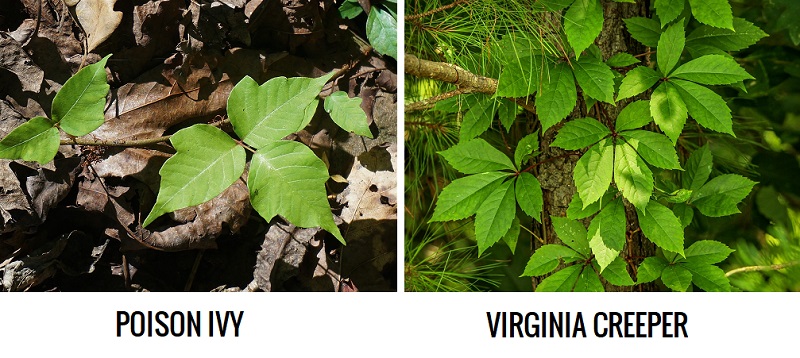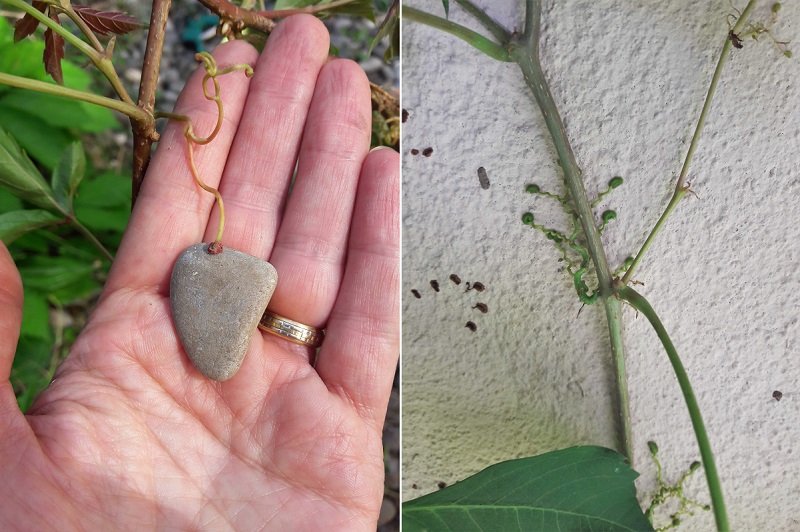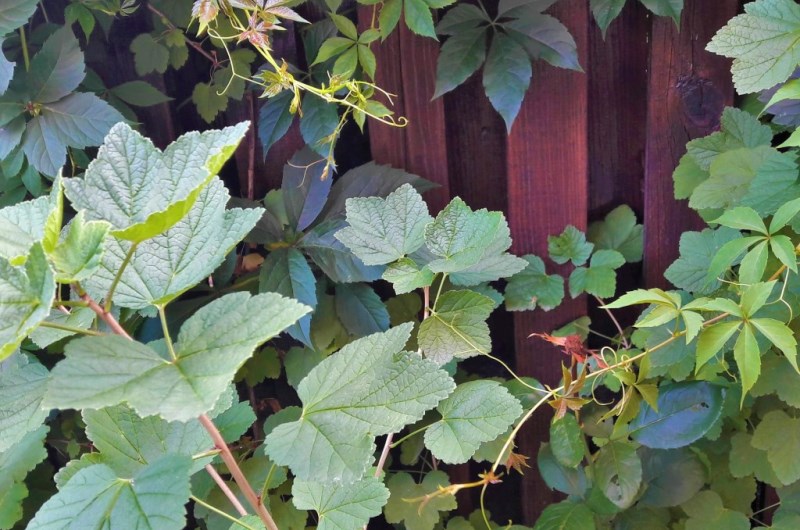You probably know this plant already, and some of you must have thought it is poisonous, which is not true. Ladies and gents, I present you one of the most affordable plants you can have in your garden: Partenocissus Quinquefolia, a.k.a. Virginia Creeper.
Despite being known as a very intrusive vine, this plant is an unbelievable resource for landscaping if you know how to tame it right. These five tricks will help you turn this vine into an asset that will make your garden wonderful year after year.
There was a time, ten years ago, when Virginia Creeper was the only plant in my garden, so I had plenty of room for experiments on driving growth and trimming. So keep reading to find out my secrets for a lovely Virginia Creeper garden decor!
Virginia Creeper versus Poison Ivy
This is the first thing to address since a lot of people make can’t make the difference, so we need to make it clear. So let’s get it right: Virginia Creeper it’s not poisonous unless you ingest its fruits, which is no the case once you read this article.
Poison Ivy has only three leaves, while Virginia Creeper has five (her Latin name includes this number – Quinquefolia) and looks very much like a paw or a hand. Do you know that Five Fingers is one if its names, in some parts of the world?
Check the picture below and tell me: can you spot the difference now?
Virginia Creeper has its poisonous parts too, but only if you ingest them. Late in the autumn, the plant will develop berries that are poisonous only for humans, but very tasty for birds and wild animals. If you pay enough attention, you’ll see how birds are actually looking for these berries during winter, as one of their favorite food sources. So here’s the rule for staying safe: don’t eat the berries!
This perennial vine grows easily in about any conditions, reaching 90-ft long, and doesn’t require much care unless the following five steps to keep it under control. It grows really fast in full sun to partial shade, in almost any type of soil, even if it’s dry or slightly alkaline. You don’t need to water it much, and it can tolerate short periods of dryness. Actually, keeping the soil too moisty might favor pests.
Get instant access to the freshest landscaping ideas & videos to spice up your home sweet home!
Now let’s see how to treat your Virginia Creeper for the best results in your garden.
1. Help it Climb
The plant needs a little help for the start, as it doesn’t branch easily. Once it has a support to climb on, it will expand and grow beautiful vines. I use rope for short distances, to help my plants climb on the fence. When they get on top, they grow and turn into a pile of vines and leaves, so the rope is no longer needed.
If you don’t provide help for climbing, the plant might find a way to do it by itself. It will grow small pads that would stick to the surface, which might be affected if it’s a painted brick wall.
On the other hand, if the plants manages to climb by itself a tree, it might grow too much and too long, and suffocate the tree, so beware!
2. Drive its Growth
When helping it climb, look for ways to direct the plant where you’ll need its foliage for a specific decor or for shading. Use trellis or arches to make the plant work for you, and check how it climbs while the vines are young so they would follow your desired path. Use garden wire to attach the plant, and don’t let it sneak through your support, so you would be able to get it down to replace or paint the trellis once in a while.
Here’s how my Virginia Creeper covers the whole fence near the parking lot, and grows around the parking sign, after driving its growth.
3. Allow Some Dangling
This plant grows beautiful vines. I don’t know about you, but I’m totally fascinated by the look of the youngest leaves on the vine. I almost feel sorry for cutting them out when trimming, so I allow them to dangle here in there.
They create a beautiful effect when left to dangle in an empty space, with nothing to climb or stick around, like this one, hanging 10-ft above the ground, from the oldest walnut tree in my backyard. This is what I call safe dangling :))))
4. Don’t Let it Creep
They call it “Creeper” for a reason, right? Despite its name, don’t let it creep or you’ll lose the best part of the show. You can still use it for covering the soil outside the walking areas, but it definitely looks much better on walls and fences.
If you’ll let your Virginia Creeper to extend on the walkways, it will develop roots that will sneak through the pavement or among the rocks, and later dislocate them from their places. Not to mention the odd look of the smashed vines and leaves…
Cut out the vines that tend to grow over the walkways or help them climb for a neat look.
5. Trim Regularly
This is the most important step when growing Virginia Creeper. Many people think this plant is too intrusive to be left alive, but I’d say it’s only a fast grower. If my hair would grow as fast, I wouldn’t call it “intrusive”, for sure :))
Yes, it will take over the garden, but you can easily keep it under control by regular trimming. After ten years of growing Virginia Creeper in my garden, let me tell you how I do it, to get the best results.
There are two types of trimming to keep your Virginia Creeper under control:
Spring Trimming: It’s the most important one, and it should be done early in the spring, after the freezing nights are gone (which means late March or early April in my area). I cut more than a half of each plant, and choose one main stem and a few branches that I shorten. I cut off all the broken or dried vines, and keep only those that are healthy enough to develop new vines in different directions.
Regular Trimming: You need them to keep the plant under control and direct it growth. I usually trim the plant from April to June once in a couple of weeks or even weekly, if needed when the new vines are growing and the plant is expanding on the set. Once the peak of the growth has gone (in late June, early July), I only trim it once every 203 weeks, to keep its shape.
Late in the autumn, my virginia Creeper comes with the reward, an awesome foliage that covers the fences in shades of crimson red, orange and olive green.
Did you change your mind about this plant already? Because this is one of a kind resource for your garden: it’s affordable, easy to grow and adaptable in almost any kind of environment!
Be your own gardener and design the garden of your dreams!


















7 comments
Going on 20 years ago In NW Oregon, I planted VC on the south side of a big, ugly, dented, metal garage and scotch-taped its new growth to the wall for two years until it was established. Yes, I keep it under control, including cutting off tendrils that escape into the garage, but it eventually completely covered the wall and is especially spectacular in the fall. And the birds loved it, too.
Yes, it looks absolutely amazing during autumn, when the leaves go red.
I live on the top floor of an apartment building (8th). We have ugly concrete balconies, so I’d love to cover the entire interior with this vine. Should I get trellises to help it position itself? I don’t want it growing on the floor of the balcony!
I’m in Montreal, Canada.
Trellises would help a lot, and it would be better than leave it climb on the wall by itself, because the tiny feet might broke the plaster.
I hope the advice will help! 🙂
I don’t think you should suggest any plant, trees or vines that are as intrusive/invasive as the Virginia creeper. You have to be a fool to believe that you have any control over where this tree killer grows. All the pruning in the world won’t stop potentially hundreds of thousands in damage to your neighbors yards as wildlife spread it everywhere.
Who cares what it looks like when it’s killing hundred yr old oak and pines while destroying anything that gets in its way under or above ground. I currently have 2 large hundred yr old oaks being killed because my idiot neighbor thinks this crap is pretty. I’ve already had to replace my entire fence more than once because this crap WILL eat through metal and wood.
There’s no talking to the neighbor because they don’t care it looks pretty. By suggesting this extremely damaging invasive vine for decoration you are setting people up for lawsuits.
I hope you don’t suggest the tallow tree too because it’s pretty. My neighbor has several of those too for the same stupid reason and in the 20 yrs they’ve been there they dug roots into my oak trees, foundation, pool and taken over the woods in my area.
If you are going to suggest gardening tips, you should be sticking to good neighbors plants. 99% of the world doesn’t give a crap if they destroy other people’s property because they want pretty. No one should be recommending anything that grows out of control, damages so much property and can bring entire trees down on your neighbor’s house.
Special note, this crap grows year round in the wetter southern states so there is no good time to “prune” or kill it to keep it under control in your own yard much less all your surrounding areas the birds are seeding for in every direction.
Responsible gardening starts with people like you. That includes never suggesting such an invasive vine, tree or plant that screws over all the neighbors of the idiot who read this and think there’s such a thing as keeping it under control and in their yard so they don’t damage private property or kill someone by dropping a tree on their house.
Nice of you to assume where this person is located in the world! Plants that are extremely vigorous and invasive in the warmth and humidity of the southern USA are much less so in colder, drier climates like Europe, where the writer lives. I am sure there are many popular plants in the gardens of Europe that would become rampant nuisances in warmer, more humid regions. I suggest you take your ire out on the neighbours you so clearly despise instead of the author here.
A plant is not “invasive” if it is native to the area. Yes, it can be aggressive, but you have your terminology wrong. And BJC is right; its effect is 100% dependent on your location, and OP lives in Europe (just look at the creeper-covered sign in the post, or the URL).
You mention “southern states,” which implies you live in the U.S. You also wrongly assume the author lives in the U.S.—which *strongly* implies you live in the U.S. Virginia creeper is, as should be obvious, native to the U.S. state of Virginia and the surrounding areas, meaning it is adapted to be a part of the ecosystem. In the wild, it lives in harmony with other native species and only becomes a problem when the native species of humans intervene and put ecosystems out of balance (including having strong opinions about the inherent value of some plants over others).
As a native plant, creeper has high value to wildlife—shelter for small mammals, food for birds, and host for sphinx moths. Demanding everyone kill it is what is irresponsible, not posting on a blog about how to control it.
If your native trees are dying, the creeper is not entirely to blame. Your neighbor isn’t entirely to blame either. Creeper spreads by birds. Are you going to sue the birds?
If you let what you consider to be a weed get so out of control on your own property that you think it’s killing 100-year-old oak trees, you have no one to blame but yourself. (Not to mention that 100 years is within the average lifespan of oak trees—so maybe just their time has come?)
Take a deep breath, then go outside and do your yard work.